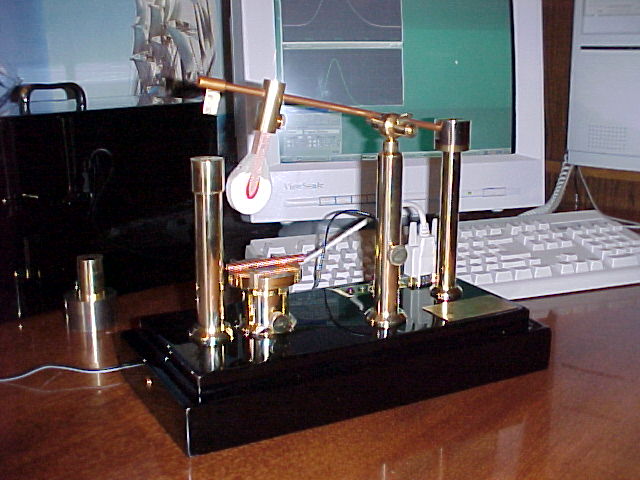
Piano Hammer Testing Device
A piano hammer is a rather complicated object. First, relationships of dynamic force versus hammer deformation show the significant influence of hysteresis, i.e. the loading and unloading of the hammer are not alike. Furthermore, the force-compression relationships of the hammer are essentially nonlinear, and the slope of the dynamic force-compression curve is strongly dependent on the hammer velocity. A model of the hammer that takes into account all the dynamical features of the hammer was derived in the paper: A. Stulov, "Hysteretic model of the grand piano hammer felt", J. Acoust. Soc. Am. v. 97 (4), 2577- 2585, 1995. According to this model the piano hammer possesses history-dependent properties or just, in other words, is made of the material with memory. In this case two additional hereditary parameters are involved to describe the hysteretic behaviour of the hammer.
To measure the nonlinear elastic and hereditary parameters of the hammer a device shown below was developed. This experimental arrangement gives a possibility to investigate the dynamical force-compression characteristics of piano hammer, and, using the hereditary (hysteretic) hammer model, to find the hammer parameters by numerical simulation of the dynamical experiments.
The device in conjunction with the hysteretic model of the piano hammer is a powerful instrument as for matching the piano hammers, as well as for their manufacturing. The numerical simulation using the hysteretic hammer model may significantly simplify the process of the manufacturing of piano hammers.
Actually, there are many parameters (e.g. the instantaneous hammer stiffness, the stiffness nonlinearity exponent, mass, radius of curvature, the hereditary parameters, and so on) describing the properties of a hammer. The conditions of piano hammers manufacturing vary also on a large scale. By using of this testing device it is possible to find the dependencies of the hammer parameters on the technological conditions during manufacturing. Therefore the knowledge of these dependencies gives a good practical hint to choose a better technological process for the hammers manufacturing. In this sense, the hysteretic hammer model is an irreplaceable model.
All the software and the testing device have been designed and developed in the Department of Mechanics and Applied Mathematics at the Institute of Cybernetics at Tallinn Technical University (Akadeemia tee 21, Tallinn, 12618, Estonia; http://www.cs.ioc.ee/ioc/).
The device includes a piezoelectrical wide-band force sensor, and a infra-red sensor for registration of hammer deformation. The analogue signals from these two sensors are converted into two set of data by a digital signal processor ADSP-2181. This 8 channels, 12 bit signal pro- cessor is produced by ADIMIR Ltd (http://www.adimir.ee/ ), and allows:
- to set up data communication speed from device sensors to computer,
- to present data in a scope mode or in an analyser ( FFT ) mode,
- to save data in a file,
- to print oscillograms and spectrograms.
The mechanical part of the piano hammer parameters testing device is produced by
Tallinn Piano Factory (41, Kungla street, Tallinn, 10413, Estonia, email: hiis@online.ee).�
The financial support of the project was provided by Estonian Innovation Fund.
Contact person: Dr. A. Stulov
Centre for Nonlinear Studies, Institute of Cybernetics
at Tallinn Technical University,
Akadeemia tee 21, Tallinn, 12618, Estonia
http://www.cs.ioc.ee/~stulov/; E-mail: stulov@ioc.ee; phone: +372 6204164